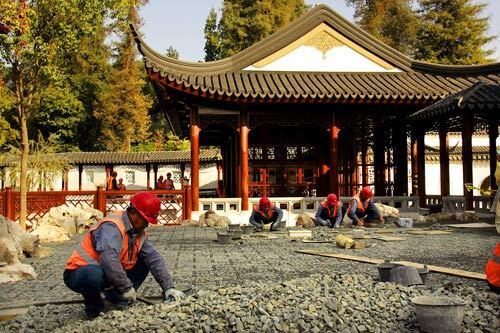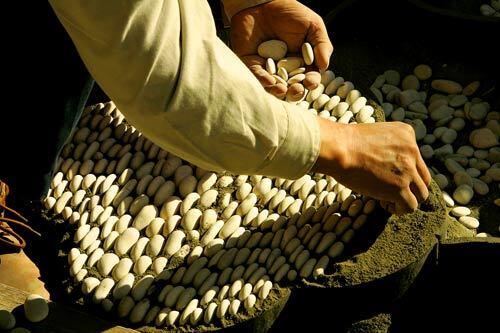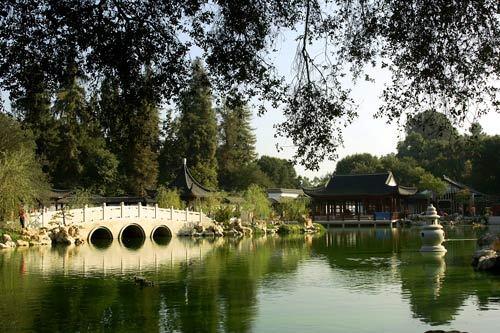A Chinese oasis in San Marino

An artisan from Suzhou, China, carves the name Bridge of Verdant Mist onto a granite bridge in the new Chinese classical garden at the Huntington Botanical Gardens in San Marino. The garden is a re-creation of one of the botanical havens built by the social elite during the Ming Dynasty, when the art of classical gardens reached its zenith in Suzhou. (Annie Wells / Los Angeles Times)

About 50 craftsmen came from Suzhou to work on the Huntington garden. Their highly specialized skills are passed down through generations. (Annie Wells / Los Angeles Times)

Sannan Wang carefully fits stones into a begonia mosaic in the Plantain Court, near the gardens entrance. (Annie Wells / Los Angeles Times)

Another view of the begonia mosaic. (Annie Wells / Los Angeles Times)
Advertisement

A nameless mosaic, with each stone gently hammered into place. (Annie Wells / Los Angeles Times)

The Cloud Wall at the entrance symbolized the separation between the hectic world outside the garden and the contemplative one within. (Annie Wells / Los Angeles Times)

Detail of the lattice on the Cloud Wall. (Annie Wells / Los Angeles Times)

An artisan sands the latticework on the Cloud Wall. (Annie Wells / Los Angeles Times)
Advertisement

Xiaolin Zhang sands the wooden doors on the gardens restaurant. (Annie Wells / Los Angeles Times)

A hand-carved wooden wall in the Love for the Lotus pavilion gets a spray of urethane finish. (Annie Wells / Los Angeles Times)

The Chinese artisans say they enjoy Monterey Park, where they are staying while they work on the project. (Annie Wells / Los Angeles Times)

The Terrace of the Jade Mirror has circular moon gates that frame carefully planned vistas. (Annie Wells / Los Angeles Times)
Advertisement

This moon gate looks onto a zigzag corridor whose nonlinear aspect is intended to fool ghosts. It also makes for a nice, meandering stroll. (Annie Wells / Los Angeles Times)

The roof tiles are made exactly as they were 500 years ago: put into molds, fired with rice straw in brick kilns for at least 40 days, and imprinted with a chrysanthemum by hand. (Annie Wells / Los Angeles Times)

Stones from Lake Tai, used in classical Chinese gardens for centuries, surround an oak tree by the water. Eight hundred tons of the limestone were shipped from the Lake Tai region for this garden. (Annie Wells / Los Angeles Times)

A view of the Jade Ribbon Bridge, and the tea house, or Freshwater Pavilion. The lake takes up 161/27 acres. (Annie Wells / Los Angeles Times)
Advertisement

The granite Jade Ribbon Bridge. (Annie Wells / Los Angeles Times)

Detail of the Jade Ribbon Bridge, which features hand-carved lotus blossoms. (Annie Wells / Los Angeles Times)

An artisan sprays clean the rustic stones that have been artfully set into place near the Jade Ribbon Bridge. (Annie Wells / Los Angeles Times)







